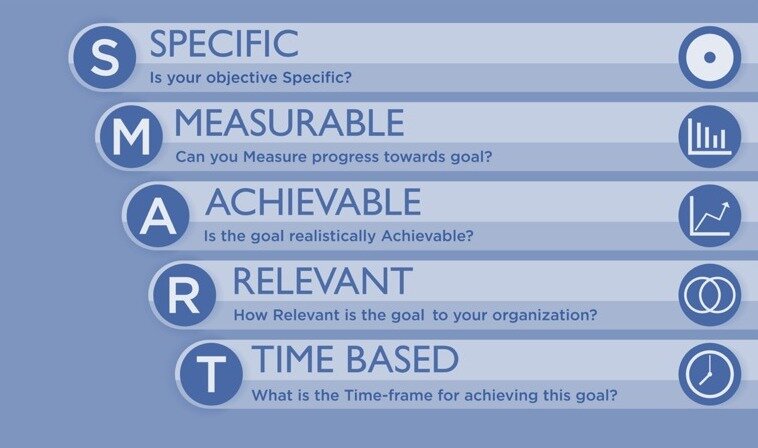How to Create Strong SMART GOALS
At first glance, coming up with your company's business goals may seem like it’s a walk in the park, or maybe it's daunting. What’s most important? Growing revenue by increasing clients? Maybe it's increasing your digital footprint or the number of visits to your website. While these goals are great and important to all businesses big and small, they lack the depth of a SMART goal. What are SMART goals you ask? Let's dive in.
S-M-A-R-T - Find out what it means to me
When we work with clients, one of the first things we ask is for them to write down their top three goals. Often times, we get lists like the one in this blog’s intro. While goals like these are important, typically the expectations are not grounded in reality. This is why we always work with our clients to revise their wants into goals that are:
(Get it? SMART 😀)
Here's an example of how any goal can be reworked into a SMART goal.
Company Y’s Goal: Increase visits to blog
Now, let's make it SMART!
Specific:
I want to boost our blog's traffic by increasing our weekly publishing frequency to our social media channels from four to six posts per week. Two of our staffers will increase their workload from writing one post per week to two posts per week. Each blog post will be shared on social media twice targeting a different persona, and our manager actively shares posts twice to her networks.
Measurable:
We want an 8% increase in blog traffic
Attainable:
Last month, blog traffic increased 5% when we increased our weekly publishing frequency from two to four posts per week. This month, we want to grow traffic to the blog to 8% by increasing weekly publishing frequency from four to six times per week.
Relevant:
By increasing blog traffic, we'll boost brand awareness and generate more leads, giving sales more opportunities to close.
Time-Bound:
End of this month
SMART Goal: At the end of this month, our blog will see an 8% lift in traffic by increasing our weekly publishing frequency on our social media channels from four posts per week to six posts per week.
Now there’s a goal that your team can work to achieve!!! So how can you turn your goals into SMART goals? Easy, download our goal setting template and get started:
Let’s write those S.M.A.R.T Goals!
Step 1. Summarize your goal
Because goals can often times live somewhere between formal marketing plans and ideas in your boss’s head, it's best to write them out. By summarizing what your goal is, you (or your team) will be forced to clarify the goal and ensure that it's the right goal for your company to be working towards right now. Be sure to keep the SMART acronym in mind when summarizing your goal!
Step 2: Categorize your goal
Are you able to put your goal into a category? According to HubSpot, goals for digital marketing often center around one of three areas, 1. Increasing visitors to website 2. Converting more visitors into leads and 3. Converting more leads into customers. Does your goal relate to one of these? If not, how will your goal impact your company’s digital marketing efforts?
Step 3: Set a specific numerical goal
Now let's talk numbers. Putting specific numerical values into your overall goal will allow you to measure it, but you can’t throw out just any number. Go back and see where you were last year and consider how ATTAINABLE your goal is. While you’ll want to go big with your goal, setting one you'll never realistically reach based on timeframe or bandwidth isn't doing you or your business any favors.
Step 4: Set a completion date
A goal is just a dream until you add a deadline. Ahhh! We wish we could take credit for that line, but some other genius thought it up. But oh, how they are right! You need to put deadlines on your goals or they have a way of dragging on F-O-R-E-V-E-R (okay, one more borrowed quote here).
By giving yourself or your team an end date you can also plan for how aggressive your marketing strategy will have to be.
Step 5: Commit the time
One word: Bandwidth.
Lofty, pie in the sky goals are great and upper management LOVES them, but does your current team have the ability to reach it given the number of hours it will take? Think about this one. If your goal is to see HUGE growth in a short period of time, consider the amount of manpower, money and time it will take to achieve it. By outlining how many hours need to be dedicated, you’ll have a way to stay on task to achieving your goal.
Step 6: Prepare for the bumps
Stuff happens, challenges arise, and without fail, our goals encounter obstacles, which makes sense. Our goals are just that – obstacles. It’s not the end of the road. Write down foreseen challenges that might arise and prepare for them, work them into your overall plan and come out ahead.
Now all that's left is to get to work and make that goal your next achievement! So, go ahead and put that celebration party on the calendar too.
Interested in how to rework your goals into SMART goals?
Start by downloading our SMART GOALS TEMPLATE!


